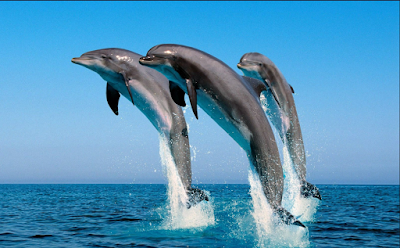Oceanic dolphins are a widely distributed family of fully aquatic marine mammals. The oceanic dolphins comprises the family Delphinidae. There are 30 extant species of oceanic dolphins. Dolphins, alongside othercetaceans, belong to the clade Cetartiodactyla with even-toed ungulates, and their closest living relatives are the hippopotamuses, having diverged about 40 million years ago.
Oceanic dolphins range in size from the 1.7 m long and 50 kg Maui's dolphin to the 9.4 m and 10.0 t killer whale, the largest known dolphin. Several species exhibit sexual dimorphism, in that the males are larger than females. They have streamlined bodies and two limbs that are modified into flippers. Though not quite as flexible as seals, some dolphins can travel at 34.5 miles per hour (55.5 km/h). Most delphinids primarily eat fish, along with a smaller number of squid and small crustaceans, but some species specialise in eating squid, or, in the case of the killer whale, also eat marine mammals and birds. All, however, are purely carnivorous. They typically have between 100 and 200 teeth, although a few species have considerably fewer. Delphinids travel in large pods, which may number a thousand individuals in some species. Each pod forages over a range of a few dozen to a few hundred square miles. Some pods have a loose social structure, with individuals frequently joining or leaving, but others seem to be more permanent, perhaps dominated by a male and a harem of females. Individuals communicate by sound, producing low-frequency whistles, and also produce high-frequency broadband clicks of 80-220 kHz, which are primarily used for echolocation. Gestation lasts from 10 to 18 months, and results in the birth of a single calf. Some species are well adapted for diving to great depths. They have a layer of fat, or blubber, under the skin to keep warm in the cold water.








